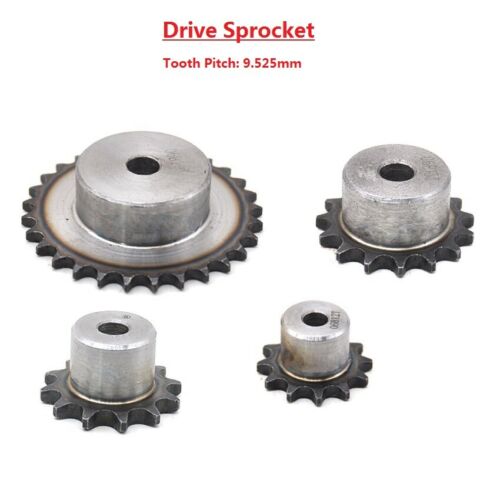-40%
Martin Roller Chain Sprocket, Reboreable, Type B Hub, Single Strand, 08B Chain S
$ 116.16
- Description
- Size Guide
Description
The item is new. The item has slight cosmetic damage (seephotos).Martin Roller Chain Sprocket, Reboreable, Type B Hub, Single Strand, 08B Chain Size, 12.7mm Pitch, 96 Teeth, 25mm Bore Dia., 395.56mm OD, 100mm Hub Dia., 7.37mm Width
For use with 08B-1 chain, 12.70 mm pitch, meets ISO metric standards
Type B sprocket offers a stable and secure attachment to the shaft
Shaft diameter size from 10 mm to 25 mm for a variety of applications
Varying numbers of teeth, pitch diameter sizes, and stock bore sizes offer application flexibility
High carbon steel for strength and durability
Product description
The Martin metric type B sprocket is suitable for use with series ISO 08B-1/metric 40 chain with 12.70 mm (0.500”) pitch for driver or driven sprocket applications. Varying numbers of teeth, pitch diameters, and stock bore sizes offer application flexibility. Made from high carbon steel, it has high strength and durability.
Type B sprockets have a hub extension on one side to provide stability and allow for the use of full-depth keyways and standard setscrews to attach the sprocket. They also can accommodate a wide range of shafts.
The chain data for this class of sprockets is BS 228/7, ISO 08B-1; pitch is 12.70 mm (0.500”); roller diameter is 8.51 mm (0.335”); roller width is 7.75 mm (0.305”); and tensile strength is 1,820 kg (4,000 lbs).
The options for this class of sprocket are: number of teeth from 9 to 114; pitch diameter from 37.13 mm to 460.91 mm; stock bore size of 10 mm to 25 mm; maximum bore size from 15 mm to 64 mm; hub diameter from 21 mm to 100 mm; length through bore from 25 mm to 35 mm; and approximate weight from 0.14 kg to 11.17 kg. The tooth width is 7.37 mm (0.290”) nominal. Maximum bores will accommodate standard keyseat and setscrew over keyseat. Slightly larger bores are possible with no keyseat, shallow keyseat, or setscrew at angle to keyseat. All Martin sprockets meet or exceed ANSI standards.
A sprocket is a wheel with teeth around the perimeter that meshes with a chain, track, or other perforated or indented material. Unlike gears that mesh with another gear, sprockets mesh with a chain, which then interacts with another sprocket. Gears can be used to transmit power around a corner, based on how they fit together. Sprockets with chains only work in straight lines. Some common benefits of chain-drive systems include minimal slippage, a fixed ratio between rotating shafts, and versatility with many different chain attachments and sprocket material selections. An example of a power transmission system is a standard bicycle, which has a sprocket and a chain to deliver power from the rider’s legs to the wheels making the bike move.
Martin Sprocket & Gear manufactures power transmission and conveying products. The company was founded in 1951 and is headquartered in Arlington, TX. Martin provides tools that meet American National Standards Institute (ANSI), National Aerospace Standard (NAS), and Deutsches Institut für Normung (DIN) standards.












